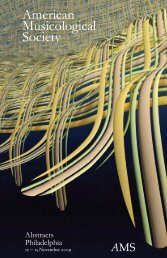Abstracts - American Musicological Society
Abstracts - American Musicological Society
Abstracts - American Musicological Society
You also want an ePaper? Increase the reach of your titles
YUMPU automatically turns print PDFs into web optimized ePapers that Google loves.
32 Thursday Afternoon: Session 1- 28<br />
AMS/SEM/SMT New Orleans 2012<br />
and spiritual, demarcating novel boundaries for public (popular) Muslim values. While much of the literature outlines implications<br />
for the Gnawa, a population of previously enslaved West Africans brought to Morocco through the slave trade, in<br />
the international music industry, the Gnawa’s expanded position in Morocco’s domestic popular culture remains neglected.<br />
Drawing upon a variety of analytical approaches, I outline techniques used by musicians to align themselves with various<br />
moral aesthetics. Vocal timbre, for example, becomes a proxy for either authenticity (in the case of the Essaouira-based Guinia<br />
family) or Sufi ritual (M’allem Abd al-Kebir’s “sweet” tone mirrors Quranic chanters), demonstrating how aesthetic decisions<br />
emphasize both spiritual legitimacy and performance practice. Second, I ask how popular musicians define the sound of the<br />
Gnawa. As Gnawa practices become part of Morocco’s aural soundtrack, pragmatic artists incorporate songs into inspired<br />
popular contexts. By questioning how actors assimilate these sounds while extracting specific moral implications, this analysis<br />
highlights the place of aural piety in the mediated musical product.<br />
Music and Altered States in Vod(o)u: Talking Spirits and the Entranced Ethnomusicologist<br />
Paul Austerlitz (Gettysburg College)<br />
The African-derived religious traditions of Haiti and the Dominican Republic provide fertile ground for elaborating upon<br />
Gilbert Rouget’s work, which showed that instead of mechanically causing trance, music is part of a larger cultural system in<br />
which altered states of consciousness are facilitated as learned behavior. Haitian Vodou and Dominican Vodu practitioners<br />
believe that music “summons” spiritual entities, who possess initiates’ bodies at public rituals. Trance states in these traditions,<br />
however, are also routinely attained by professional mediums without the aid of music during private consultations with<br />
clients. What, then, is the role of music? The present work tackles this question by 1) attending to interviews conducted with<br />
mediums when they exhibit everyday waking consciousness as well as when they are possessed by spirits; and 2) attending to<br />
the experiences of the author, who is an initiate and trancer in Haitian and Dominican Vod(o)u. The paper argues that music<br />
paves the way for altered states: as in secular contexts, it enlivens and entrains, facilitating psychic transcendence. While novices<br />
rely on music to effect trance, seasoned professional mediums do not. This insight broaches larger questions about how<br />
music is experienced in African-influenced cultures, suggesting that talking to Vod(o)u spirits and attending to the ethnomusicologist’s<br />
entrancement are fruitful avenues for understanding the efficacy of music.<br />
An Acoustemology of Struggle: Indigeneity, Land Conflict, and the<br />
Toré Ritual of the Brazilian Tapeba People<br />
Ronald Conner (University of California, Los Angeles)<br />
In recent decades, the Toré—a sacred ritual consisting of collective singing, percussion accompaniment, circle dancing, and<br />
shamanic activity—has come to symbolize the identity claims and land struggles of reemerging indigenous groups throughout<br />
Northeast Brazil. Among them, the Tapeba people (population 6,580) of Caucaia, Ceará, have been engaged in a quartercentury<br />
of negotiations and conflicts with federal and state government, local law enforcement, and white landholders, in<br />
their attempt to secure official recognition as Amerindians and regain rights to traditional lands lost through processes of<br />
colonization and acculturation. Drawing on six months of recent fieldwork among the Tapeba (2011–12), prior area scholarship<br />
(Barreto Filho 1993; Warren 2001; French 2009), and Feld’s (1994a, 1994b, 2003) notion of acoustemology positioning sound<br />
as a “modality of knowing and being in the world,” I examine how the Tapeba strategically employ Toré performances to<br />
reassert indigenous identity in a state where Amerindians are commonly thought to be extinct and, perhaps most remarkably,<br />
sonically demarcate their lands while awaiting a disastrously stalled federal demarcation process to resume. In this, Toré songs<br />
constitute not only a recognizable tradition contesting the official history of indigeneity in Ceará but a vital musical practice<br />
articulating local knowledge and the experience of luta, “struggle,” a concept powerfully imbricated in Tapeba identity consciousness<br />
and Tapeba relationships to land access, their threatened natural environment, and everyday survival within the<br />
dominant and rapidly modernizing Northeast Brazilian context.<br />
“Outside the House There Are No Laws”: Song, Sacred Space, and<br />
Social Relations at Shona Kurova Guva Rituals<br />
Jennifer Kyker (University of Rochester)<br />
The Shona ritual of kurova guva marks a moment of spiritual transformation, during which the spirit of a deceased individual<br />
is symbolically purified, carried home, and transformed into a mudzimu ancestor capable of interceding in the lives of<br />
living kin. Held a year after the funeral, kurova guva encompasses an unusual diversity of musical styles, integrating overlapping<br />
spheres of song, and resulting in a rich and sometimes cacophonous sonic texture. In particular, participants at kurova<br />
guva distinguish between the religious, familial, and ancestral associations of musical genres such as mbira, played inside the<br />
house of the deceased by family elders, and the secular, recreational qualities of genres such as jiti and jerusarema, performed










